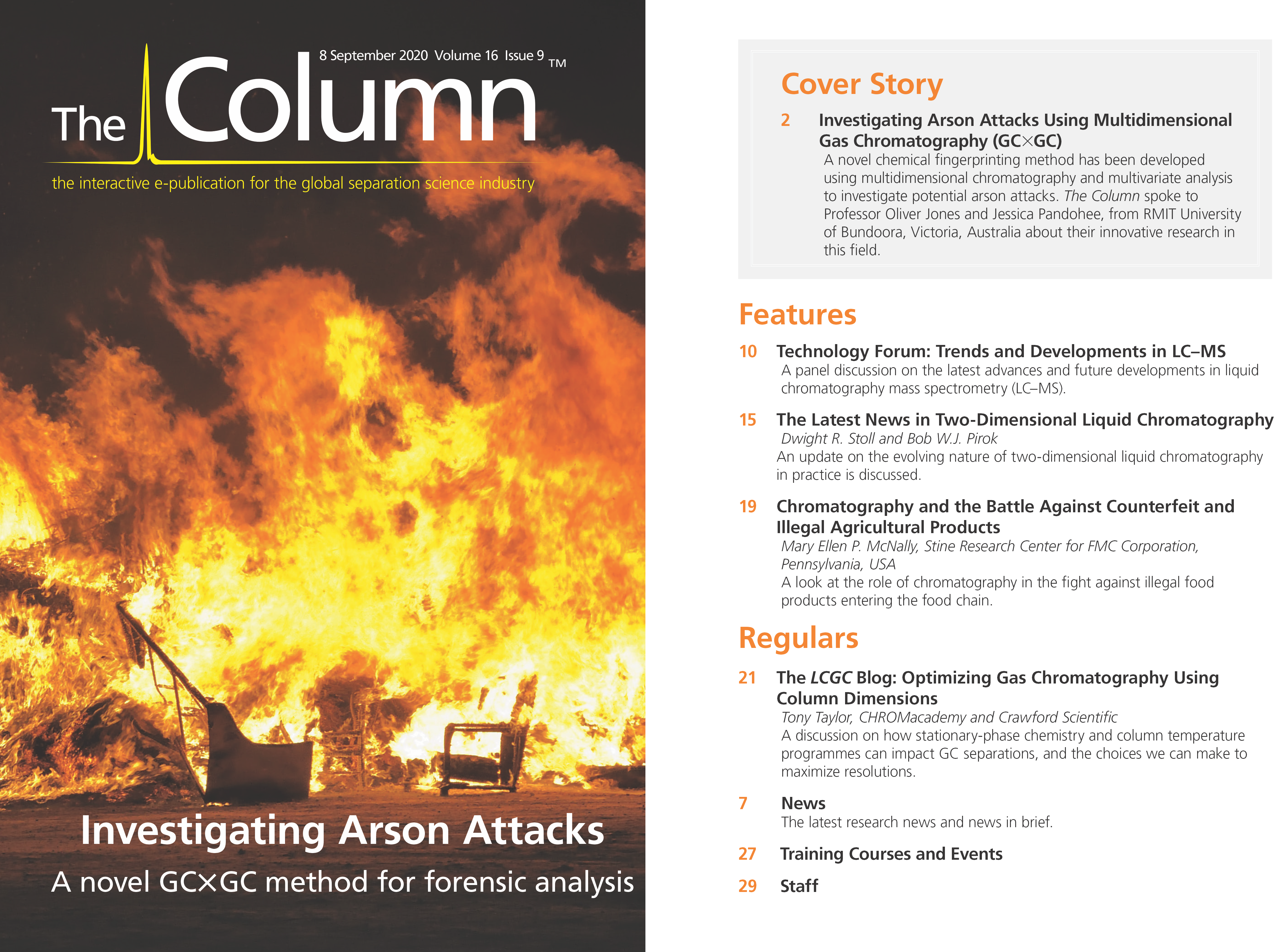Chromatography and the Battle Against Counterfeit and Illegal Agricultural Products
A look at the role of chromatography in the fight against illegal food products entering the food chain.
winyu/stock.adobe.com

Estimated losses due to counterfeit and illegal products in the agricultural and pharmaceutical industries comprise a staggering 10% of global trade, and for some nations like Brazil it is believed to be closer to 20% (1,2). The impact of counterfeit and illegal material goes far beyond the loss of sales, however, extending into brand integrity damage and trademark dilution as well as the high cost of enforcing intellectual property rights and protection. In agriculture, residual effects of counterfeit products that are introduced into our food chain, if not manufactured correctly or used according to the registered specifications, have the potential to affect the environment as well as the health and well-being of consumers.
Legitimate commercial pharmaceutical and agricultural producers, after many years of work to prove the safety of their products, submit analytical methods for the identification and quantitation of technical active ingredients and full formulations to regulatory agencies worldwide. These methods, referred to as enforcement methods, verify that products sold meet the registered labelled specifications. Specifically, these methods are used to determine the identity and amount of the active ingredient or ingredients that are present.
Regulatory agencies can use these individual product enforcement methods to bring legal action when suspect samples are found. A suspect product can be defined as any of the following: a product purposely manufactured to mimic a registered and trademarked material under patent, a product purposely sold in a container to mimic a registered product’s container and label, a product purposely sold under an accepted tradename but containing another product, a product purposely sold under an accepted tradename with no active ingredient present, or a product sold with an incorrect active ingredient present.
Most suspect samples found and believed to be from counterfeit suppliers and illegal sources are formulated products. As such, the active ingredient is just a portion of the components making up the marketed product, with the percentage of active ingredient ranging from as low as 0.2% to as high as 75–80%, depending on the strength of the active ingredient and the registered use of the formulated product. The rest of the ingredients are coformulating agents. These coformulants are a variety of materials, including but not limited to dispersants, biocides, binders, dyes, stabilizers, emulsifiers, adjuvants, wetting agents, antifoams, clays, gums, flow aids, and diluents. Basically, the coformulants are a broad array of chemical substances with varying physical properties to help the active ingredient reach the target portion of an organism. Original recipes of formulations are considered confidential information by the registered manufacturers and by regulatory authorities in most countries. As a result, it is difficult for the counterfeiters and illegal manufacturers to match the original formulations, particularly if the original formulations are complex and expensive. Consequently, counterfeit and illegal samples likely will have not only variability of the active ingredient but also differences in coformulant ingredients. Simply, this means counterfeit and illegal products could contain the same coformulants as the original product but most likely will not. The coformulants will probably be from different sources, in varying amounts or ratios, or both, than what was original to the registered product. Such differences in coformulants can also affect the efficacy and safety of the product.
Enforcement methods are typically based on liquid or gas chromatography (LC or GC) and are part of the arsenal of analytical tools used to verify that products are authentic. These methods are validated under good laboratory practice (GLP) guidelines and thus undergo standard validation parameters required to ascertain the rigour of the measurement, including the precision, accuracy (recovery), linearity, and specificity of the active ingredient.
When a counterfeit or illegal suspect sample is tested for its authenticity, the most straightforward and uncomplicated test is active ingredient identification. A chromatographic retention time confirmation is a quick screen to start this identification. Even with more than 1055 active pesticide ingredients authorized for use in the United States alone, which yield more than 20 000 marketed products, chromatography can positively eliminate the majority of those present (3,4). Then, if necessary, a confirmation conducted with UV spectroscopy or mass spectrometry (MS) can provide definitive identification. In clear‑cut cases where chromatography is used as a screening technique, one can readily determine if a product has an incorrect active ingredient present, no active ingredient at all, or several active ingredients instead of one, and the appropriate response can be taken, even without further confirmatory techniques.
As the complexity of suspect samples increases, separation methods in combination with advanced confirmatory techniques are needed to determine the exact sources of material, whether authentic, generic, counterfeit, or illegal. Upfront, the challenge is often to determine how much analytical data should be required to prove inauthenticity, which is vital to stopping this rampant criminal activity. Chromatographic techniques are key technologies to not only solve some of these challenging problems but also to determine how much further work may be required.
References
- J.W. Leem, M.S. Kim, S.H. Choi, S.-R. Kim, S.-W. Kim, Y.M Song, R.J. Young and Y.L. Kim, Nature Commun. 11, 328 (2020).
- T. McCoy, The Washington Post, February 9, 2020.
- L.R. Goldman, J. Agromedicine 12(1), 67–75 (2007).
- NIOSH, CDC gov, February 7, 2017.
Mary Ellen P. McNally, PhD, is a Global R&D Fellow at the Stine Research Center for FMC Corporation, Pennsylvania, USA. Her specialties include separations and method development using liquid chromatography, gas chromatography, and supercritical fluid chromatography; sample preparation focused on agricultural products; and ultratrace level analysis and detection. She was employed by DuPont for 33 years before joining FMC, receiving awards including DuPont Crop Protection’s Scientific Leadership Award
E-mail: Mary-Ellen.McNally@fmc.com
Website: www.fmc.com

Determining Enhanced Sensitivity to Odors due to Anxiety-Associated Chemosignals with GC
May 8th 2025Based on their hypothesis that smelling anxiety chemosignals can, like visual anxiety induction, lead to an increase in odor sensitivity, a joint study between the University of Erlangen-Nuremberg (Erlangen, Germany) and the Fraunhofer Institute for Process Engineering and Packaging (Freising, Germany) combined behavioral experiments, odor profile analysis by a trained panel, and instrumental analysis of odorants (gas chromatography-olfactometry) and volatiles (gas chromatography-mass spectrometry).
Investigating 3D-Printable Stationary Phases in Liquid Chromatography
May 7th 20253D printing technology has potential in chromatography, but a major challenge is developing materials with both high porosity and robust mechanical properties. Recently, scientists compared the separation performances of eight different 3D printable stationary phases.
Detecting Hyper-Fast Chromatographic Peaks Using Ion Mobility Spectrometry
May 6th 2025Ion mobility spectrometers can detect trace compounds quickly, though they can face various issues with detecting certain peaks. University of Hannover scientists created a new system for resolving hyper-fast gas chromatography (GC) peaks.

.png&w=3840&q=75)

.png&w=3840&q=75)



.png&w=3840&q=75)



.png&w=3840&q=75)









